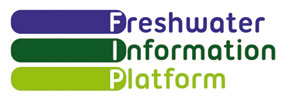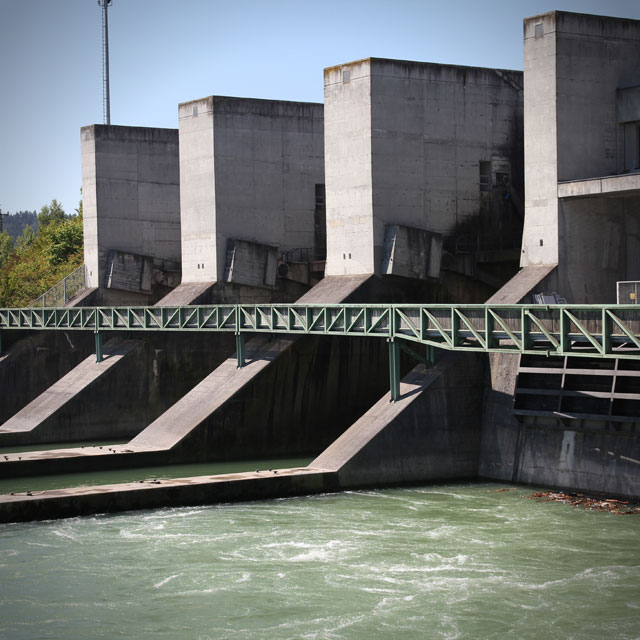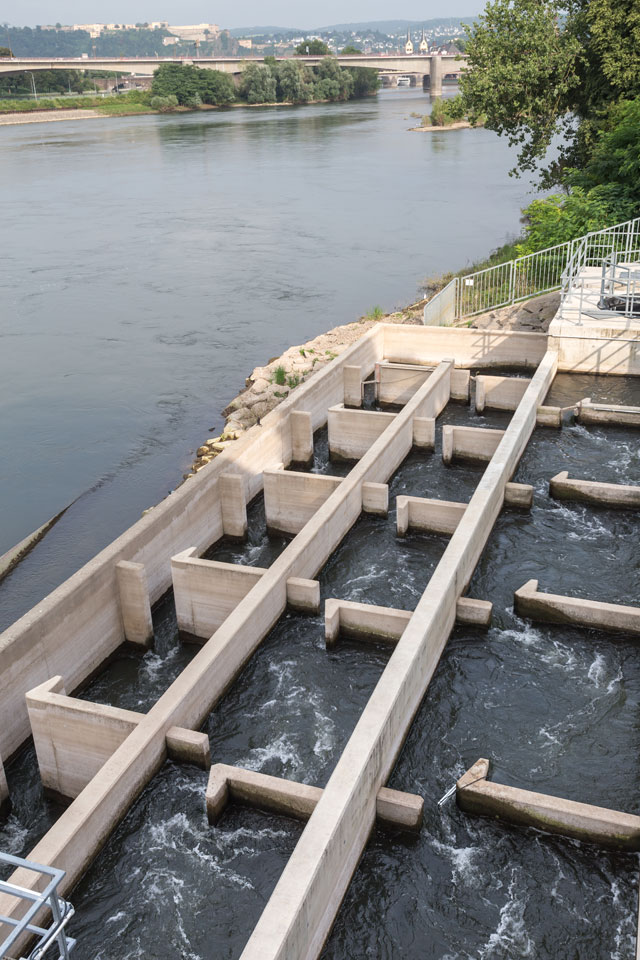Energy
Water is used in large volumes in the production of energy by a range of means, most notably thermal generation (which includes nuclear and the burning of fossil fuels) and hydropower. Currently, thermal generation provides around 75% of European electricity, and hydropower a further 17%, meaning freshwater use is intrinsic in European power generation (van Vliet et al. 2013). The growth in popularity of shale gas extraction, steam injection, hydraulic fracturing, and horizontal drilling – all of which require high inputs of water – means that the water use per mega joule of energy produced in Europe is likely to increase into the future (EEA 2012a). Water quantity and health may also impacted by renewable energy production, particularly hydropower and bio-energy cultivation (through the irrigation of biofuels crops).
Hydropower has been recognised as one of the main drivers in the changing hydromorphology of European rivers, reducing ecological connectivity, altering flows of water, species, nutrients and sediment (EEA 2012b). However, as a renewable energy source, the number of hydropower plants (and their associated reservoirs, dams and weirs) is likely to increase over the coming decades in the face of climate change, and government attempts to limit our dependence on fossil fuels. It is therefore important that the potential negative impacts of hydropower production for aquatic ecosystems are taken into account in planning.
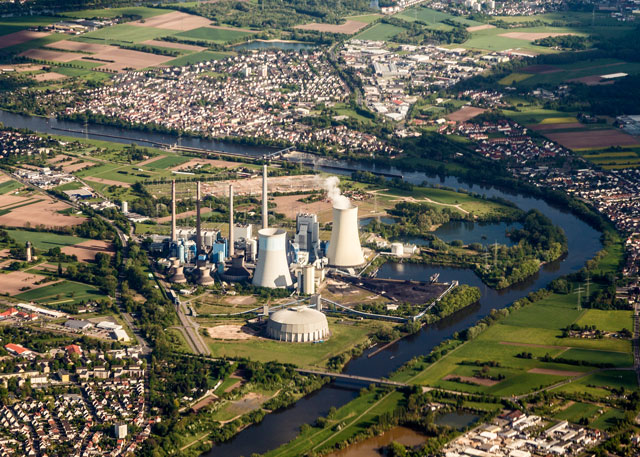
Power plant Grosskrotzenburg at river Main, Germany
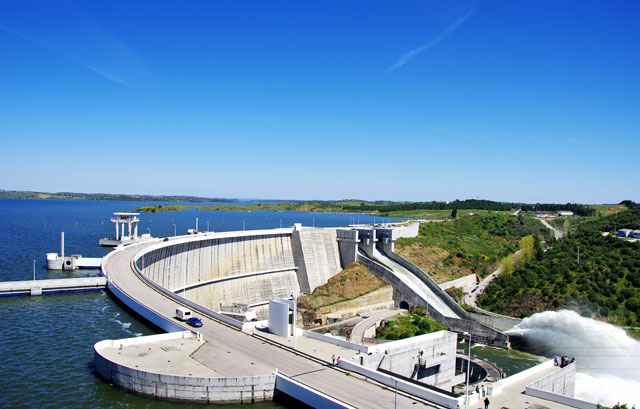
Energy production in river Guadiana, Alqueva Multipurpose Project, Portugal
Energy production pressures
Abstraction/flow diversion: Energy production requires significant inputs of freshwater. In Western Europe, over 50% of abstracted water is used in energy production. Thermal, fossil and nuclear power plants all require large amounts of water for the generation of electricity and heating. Almost 100% this water is subsequently returned (post-treatment) to the abstracted water body. However, a growth in the use of biomass fuels has negative implications for water, as abstraction for agriculture is far less water efficient (EEA 2012a).
Physical and hydrological alteration: Hydropower projects alter both the physical and hydrological character of a river. Reservoir, dam and weir construction to generate hydropower fragment water bodies and their ecological flows. As hydropower plants generate energy in response to demand, water release can be highly variable, leading to marked fluctuations in downstream water quantity and velocity – or hydropeaking. Hydropeaks can rapidly alter river hydrology; placing pressure on invertebrate, plant and fish populations (which may be forced to ‘drift’ or be stranded by receding water levels) and potentially causing periodic channel erosion in downstream ecosystems.
Change in thermal, mixing or ice regime: Water used for cooling in thermal power plants is returned to the environment, sometimes at a higher temperature than that at which it was extracted (EEA 2012a).
Point and diffuse pressures: Water bodies are at risk of pollution from a range of energy production methods. Particularly notable is shale gas extraction, which has been found to carry a high risk of surface and groundwater contamination, water resource depletion and damage to aquatic biodiversity (EEA 2012b).

Map of 25 top European Countries of total installed capacity SHP (Small Hydropower stations(<10MW)), total generation energy SHP and number of SHPs in 2010 (Manzano-Agugliaro et al. 2017)
Geographical distributions and trends
There are around 23,000 hydropower plants in EU-27 countries, of which 7,700 are in Germany, whilst Austria, France, Italy and Sweden all have more than 2,000 hydropower plants each, many of which are located in mountainous regions (EEA 2012). Such generation occurs at a range of scales, from the Ulla-Førre hydroelectric complex in Norway, with a production capacity of 2,057 megawatts, to small weirs serving only a handful of households. Although there are around ten times more small than large hydropower stations, large hydropower plants generate more than 85% of the hydropower used in Europe (EEA 2012). Hydropower is most common in the north of Europe, and in the Alpine regions.
Thermal energy production is commonplace in countries all across Europe. The potential for shale gas production, which requires significant inputs of water and has a high potential for pollution, differs by region. France and Poland have the largest potential shale gas reserves. However, where Poland has already started exploratory drilling, France has currently banned ‘fracking’. Bulgaria and the Netherlands also currently have moratoriums, and Germany is taking a precautionary approach. Regulations in the UK, Spain, Poland, Romania, Lithuania and Denmark are all supportive of ‘fracking’ (EP 2014).
Potential for 'water friendly' mitigation
The impacts of hydropower on rivers can be mitigated through a range of methods, such as restoring connected wetlands in the areas around hydropower installations; installing fish passes to allow for upstream and downstream migration; setting minimum ecological flow requirements to reduce disruption of flow dynamics and hydropeaking; and managing sediment to avoid downstream erosion (EEA 2012b).
Hydropeaking can be further mitigated by structural measures, such as the creation of basins that buffer high discharges through temporary retention, or the diversion of discharge water into parallel channels. Closed system hydropower, which re-uses the same body of water through pumping to upper reservoirs rather than abstracting new water from a river each time, has less impact on river ecosystem health and hydromorphology (EEA 2012a).
In industrial and energy production, technological advances may allow for increasingly water-efficient practices and wastewater recycling, whilst consideration may be given to the temperature, quantity, quality and timing of water releases back into water bodies in order to minimise the pressures generated (EEA 2012).
Further reading
Reports and publications:
EEA (2012a). European waters - assessment of status and pressures (Download report, 28mb)
EEA (2012b). Towards efficient use of water resources in Europe (Download report, 3.8mb)
EPRS (2014). Shale Gas and EU Energy Security European Parliament Briefing (Download report, 1mb)
Manzano-Agugliaro F., Taher M., Zapata-Sierra A., Juaidi A. & F.G. Montoya (2017). An overview of research and energy evolution for small hydropower in Europe, Renewable and Sustainable Energy Reviews, Vol. 75, pp 476-489. DOI: 10.1016/j.rser.2016.11.013 (Read abstract)
Van Vliet, M.T., Vögele, S., & D. Rübbelke & D. (2013). Water constraints on European power supply under climate change: impacts on electricity prices. Environmental Research Letters, 8(3), 035010. DOI:10.1088/1748-9326/8/3/035010 (Download article, 1mb)
Selected Freshwater blogs:
Freshwaterblog (2014). How will the hydropower boom affect global river ecosystems? (External website)
Freshwaterblog (2016). Balancing hydropower and biodiversity in the Amazon, Congo, and Mekong basins (External website)
Freshwaterblog (2016). Investigating the effects of water releases from hydropower on Alpine stream ecosystems (External website)
Freshwaterblog (2017). Mitigating the ecological effects of water storage pressures (External website)
Freshwaterblog (2017). The politics of biodiversity and hydropower on ‘Europe’s last wild river’ (External website)
Freshwaterblog (2017). Hydropower and fish: reporting on a Brussels workshop (External website)

